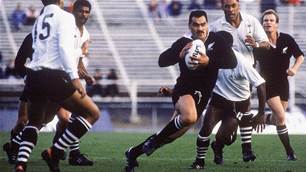Ten years ago, Bridport, on the north-east coast of Tasmania, was little more than a sleepy fishing village.
Ten years ago, Bridport, on the north-east coast of Tasmania, was little more than a sleepy fishing village. It was about this time that the biggest landowner in the area, businessman turned potato farmer Richard Sattler, signed off on building a golf course on his beachside property, just east of town.
The spectacular par-3 15th beneath the new restaurant and spa.
When the Tom Doak and Mike Clayton-designed Barnbougle Dunes officially opened for play in 2004 there had already been hundreds of rounds played on the course. “They’ve been playing out there for months,” I recall theBridport bakery shop assistant telling me during my first visit for the opening. “We’ve had Americans and Brits here already and they’ve come all this way to play the course.
“It must be pretty good,” she added.
Indeed Barnbougle Dunes is that good and remains one of this country’s best layouts. Now it has a new neighbour – Barnbougle Lost Farm – and for those, including myself, who have already had the privilege of playing the layout, it has the potential to be considered an even better course.
At this point it must be said that the two courses are different in many ways and comparing one with the other is difficult. Where Barnbougle Dunes offers one visually spectacular hole after another, the Bill Coore-designed Lost Farm combines the spectacular with holes that place the highest possible value on good strategy from tee-to-green.
Coore’s aim was to make Lost Farm a different golfing experience to Barnbougle Dunes and he has succeeded on every level.
“People are always asking if this course will be better than the Dunes course and there’s no way it could be,” Coore told Golf Australia earlier this year.
“They are different. You can’t believe how different the land is for two courses so geographically close to each other. What we have hopefully done is build a course which complements the first course, that’s what we’ve tried to achieve.
“If some people prefer Lost Farm and others prefer Barnbougle Dunes then that means both must have something right.”
The approach into the 3rd green is best from the right half of the fairway.
I found it hard to split the two courses. However, many will consider Lost Farm a better layout because it has holes that run to different points of the compass, where nearly all the holes at Barnbougle Dunes follow the east-west line of the sand dunes.
Lost Farm opens with a quality par-5 and short par-4 before ramping up the excitement with another diminutive two-shotter at the 3rd. Played slightly uphill, the hole measures no more than 250-metres from the back pegs.
Unlike Barnbougle Dunes where many of the fairways, particularly on the front nine, appeared to have been squeezed into the flattest areas between the towering sand dunes, Lost Farm’s fairways weave through much wider valleys. On the 3rd, the fairway is wider than a four-lane highway but the key is hitting to the right part of the expanse to get the best approach. Here, it is from the right side on a small shelf, which sits several metres above the widest stretch of landing zone, and presents an uncomplicated line into the angled green.
The following hole, a 110-metre par-3, promises to be one of the most talked about short holes in world golf. It resembles the famed 7th at Pebble Beach without the steep elevation change between tee and green. Coore’s green complex is perfectly located on a spit of land where the beach borders the hole to the right and the mouth of the Little Forester River can be seen beyond the putting surface. On the day I played I used a 6-iron into the wind to cover the distance to a back pin. On the rare still days it is no more than pitch or 9-iron.
The hole is known as Sal’s Point because Sally Sattler, Richard’s wife, thought it would make a great spot to build their dream home.
“It would be a good spot but it makes a much better golf hole,” Sattler laughs as he recounts just one of the dozens of stories connected with building Lost Farm.
Sal's Point, Lost Farm's soon-to-become famours par-3 4th hole.
Sattler spent many hours walking the property with Coore working out green and tee sites.
“Bill told me there were 20 good holes out there and I should choose the best 18,” Sattler says. “I told him he was the expert and he should choose. In the end we kept all 20.”
Yes, that’s another unique aspect about Lost Farm. It has 20 holes, with the two additional holes, 13a and 18a, both being par-3s.
Actually the par-3s are a real strength of Coore’s design at Lost Farm. Arguably the best of them is the 160-metre 15th, which offers the final ocean view of the round. The tee is perched above the beach and you play down to a massive green that lies wedged between scrub covered dunes right and a 30-metre high dune to the left. The top of this dune is now home to Lost Farm’s restaurant and the soon-to-be-opened wellness centre.
Lost Farm is a wonderful and highly anticipated new addition to the Australian golfing landscape and it won’t be long before its impact is felt on national ranking lists. The design is world class and with more growing time, the playing surfaces will be equally as impressive.
Address: Waterhouse Rd, Bridport, Tasmania.
Designer: Bill Coore.
Green fee: $98.
Contact: O438 561 641 or email reservations@lostfarm.com.au
Visitors: Lost Farm had a soft opening in October but will officially open for visiting golfers on December 10. Lost Farm is a public access course with tee times available seven days a week.
Related Articles

International Spotlight: Omanu Golf Club

Celebrity Kiwi couple tee off in paradise













